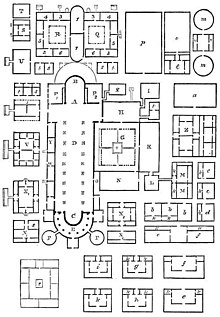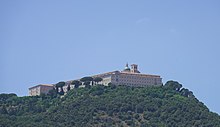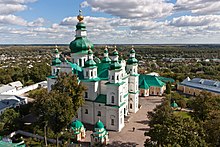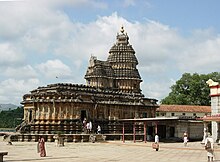Monastery
This articleneeds additional citations forverification.(September 2023) |

Amonasteryis a building or complex of buildings comprising the domestic quarters and workplaces ofmonastics,monksornuns,whether living incommunitiesor alone (hermits). A monastery generally includes a place reserved for prayer which may be achapel,church,ortemple,and may also serve as anoratory,or in the case ofcommunitiesanything from a single building housing only one senior and two or three junior monks or nuns, to vast complexes and estates housing tens or hundreds. A monastery complex typically comprises a number of buildings which include a church,dormitory,cloister,refectory,library,balnearyandinfirmary,and outlyinggranges.Depending on the location, the monastic order and the occupation of its inhabitants, the complex may also include a wide range of buildings that facilitate self-sufficiency and service to the community. These may include ahospice,aschool,and a range of agricultural and manufacturing buildings such as abarn,aforge,or abrewery.
In English usage, the termmonasteryis generally used to denote the buildings of a community of monks. In modern usage,conventtends to be applied only to institutions of female monastics (nuns), particularly communities of teaching or nursingreligious sisters.Historically, a convent denoted a house offriars(reflecting the Latin), now more commonly called afriary.Various religions may apply these terms in more specific ways.
Etymology[edit]

The wordmonasterycomes from theGreekwordμοναστήριον,neut. ofμοναστήριος–monasteriosfromμονάζειν–monazein"to live alone"[1]from the rootμόνος–monos"alone" (originally all Christian monks were hermits); the suffix "-terion" denotes a "place for doing something". The earliest extant use of the termmonastērionis by the 1st century ADJewishphilosopherPhiloinOn The Contemplative Life,ch. III.
In England, the wordmonasterywas also applied to the habitation of abishopand thecathedralclergywho lived apart from the lay community. Most cathedrals were not monasteries, and were served bycanons secular,which were communal but not monastic. However, some were run by monasteries orders, such asYork Minster.Westminster Abbeywas for a short time a cathedral, and was aBenedictinemonastery until theReformation,and itsChapterpreserves elements of the Benedictine tradition. See the entrycathedral.They are also to be distinguished from collegiate churches, such asSt George's Chapel, Windsor.
Terms[edit]
The termmonasteryis used generically to refer to any of a number of types of religious community. In theRoman Catholicreligion and to some extent in certain branches ofBuddhism,there is a somewhat more specific definition of the term and many related terms.
Buddhistmonasteries are generally calledvihara(Palilanguage el). Viharas may be occupied by men or women, and in keeping with common English usage, a vihara populated by females may often be called a nunnery or a convent. However, vihara can also refer to atemple.In Tibetan Buddhism, monasteries are often calledgompa.InCambodia,LaosandThailand,a monastery is called awat.InBurma,a monastery is called akyaung.
A Christian monastery may be anabbey(i.e., under the rule of anabbot), or apriory(under the rule of aprior), or conceivably ahermitage(the dwelling of ahermit). It may be a community of men (monks) or of women (nuns). Acharterhouseis any monastery belonging to theCarthusianorder. InEastern Christianity,a very small monastic community can be called askete,and a very large or important monastery can be given the dignity of alavra.
The great communal life of a Christian monastery is calledcenobitic,as opposed to theanchoretic(or anchoritic) life of ananchoriteand theeremiticlife of ahermit.There has also been, mostly under theOsmanlioccupation of Greece and Cyprus, an "idiorrhythmic" lifestyle where monks come together but being able to own things individually and not being obliged to work for the common good.
InHinduismmonasteries are calledmatha,mandir,koil,or most commonly anashram.
Jainsuse the Buddhist termvihara.
Monastic life[edit]

In most religions, life inside monasteries is governed by community rules that stipulate the gender of the inhabitants and require them to remaincelibateand own little or no personal property. The degree to which life inside a particular monastery is socially separate from the surrounding populace can also vary widely; some religious traditions mandate isolation for purposes of contemplation removed from the everyday world, in which case members of the monastic community may spend most of their time isolated even from each other. Others focus on interacting with the local communities to provide services, such as teaching, medical care, orevangelism.Some monastic communities are only occupied seasonally, depending both on the traditions involved and the local climate, and people may be part of a monastic community for periods ranging from a few days at a time to almost an entire lifetime.[citation needed]
Life within the walls of a monastery may be supported in several ways: by manufacturing and selling goods, oftenagriculturalproducts; by donations oralms;by rental or investment incomes; and by funds from other organizations within the religion, which in the past formed the traditional support of monasteries. There has been a long tradition of Christian monasteries providing hospitable, charitable and hospital services. Monasteries have often been associated with the provision of education and the encouragement of scholarship and research,[2]which has led to the establishment of schools and colleges and the association with universities. Monastic life has adapted to modern society by offering computer services,accountingservices and management as well as modern hospital and educational administration.[3]
Buddhism[edit]


Buddhist monasteries, known asvihārainPaliand inSanskrit,emerged sometime around the fourth century BCE from the practice ofvassa,a retreat undertaken by Buddhist monastics during the South Asianwet season.To prevent wanderingmonksandnunsfrom disturbing new plant-growth or becoming stranded in inclement weather, they were instructed to remain in a fixed location for the roughly three-month period typically beginning in mid-July.
These early fixedvassaretreats took place in pavilions and parks that wealthy supporters had donated to thesangha.Over the years, the custom of staying on property held in common by thesanghaas a whole during thevassaretreat evolved intocenobitic monasticism,in which monks and nuns resided year-round in monasteries.
InIndia,Buddhist monasteries gradually developed into centres of learning where philosophical principles were developed and debated; this tradition continues in the monastic universities ofVajrayana Buddhists,as well as in religious schools and universities founded by religious orders across the Buddhist world. In modern times, living a settled life in a monastery setting has become[when?]the most common lifestyle for Buddhist monks and nuns across the globe.
Whereas early monasteries are considered[by whom?]to have been held in common by the entire sangha, in later years this tradition diverged in a number of countries. Despitevinayaprohibitions on possessing wealth, many monasteries became large landowners, much like monasteries in medieval Christian Europe. InChinese Buddhism,peasant families worked monastic-owned land in exchange for paying a portion of their yearly crop to the resident monks in the monastery, just as they would to afeudallandlord. InSri Lankaand inTibetan Buddhism,the ownership of a monastery often became vested in a single monk, who would often keep the property within the family by passing it on to a nephew ordained as a monk. InJapan,where civil authorities permitted Buddhist monks to marry, the position of head of a temple or monastery sometimes became hereditary, passed from father to son over many generations.
Forest monasteries – most commonly found in theTheravadatraditions of Southeast Asia and Sri Lanka – are monasteries dedicated primarily to the study and cultivation ofBuddhist meditation,rather than to scholarship or ceremonial duties. Forest monasteries often function like early Christian monasteries, with small groups of monks living an essentially hermit-like life gathered loosely around a respected elder teacher. While thewandering lifestylepractised bythe Buddhaand by his disciples continues to be the ideal model for forest-tradition monks inThailand,Myanmar,Sri Lankaand elsewhere, practical concerns - including shrinking wilderness areas, lack of access to lay supporters, dangerous wildlife, and dangerous border conflicts - dictate that increasing numbers of "meditation" monks live in monasteries, rather than wandering.
Tibetan Buddhist monasteries orgompasare sometimes known aslamaseries,with their monks sometimes (mistakenly) known aslamas.Helena Blavatsky'sTheosophical Societynamed its initial New York City meeting-place "the Lamasery".[4]
Famous Buddhist monasteries include:
- Donglin Temple,Jiangxi,China
- Jetavana,Shravasti(India)
- Nalanda,India
- Shaolin Monastery,China
- Tengboche,Nepal
For a further list of Buddhist monasteries seelist of Buddhist temples.
Trends[edit]
Buddhist monasteries include some of the largest in the world.Drepung Monasteryin Tibet housed around 10,000 monks prior to theChinese invasion[5][6] in 1950–1951. As of 2020[update]the relocated monastery in India houses around 8,000.[citation needed]
Christianity[edit]

According to tradition,Christian monasticismbegan inEgyptwithAnthony the Great.Originally, all Christian monks werehermitsseldom encountering other people.[7]
A transitional form of monasticism was later created byAmmonasin which "solitary" monks lived close enough to one another to offer mutual support as well as gathering together on Sundays for common services.[8]
It wasPachomius the Greatwho developed the idea ofcenobitic monasticism:having renunciates live together and worship together under the same roof. Some attribute his mode of communal living to thebarracksof theRoman Armyin which Pachomios served as a young man.[9]Soon the Egyptian desert blossomed with monasteries, especially around Nitria (Wadi El Natrun), which was called the "Holy City". Estimates are that upwards of 50,000 monks lived in this area at any one time.[citation needed]Hermitism never died out though, but was reserved only for those advanced monks who had worked out their problems within a cenobitic monastery.[citation needed]
The idea caught on, and other places followed:
- Upon his return from theCouncil of Serdica,Athanasius of Alexandriaestablishedthe first Christian monastery in Europecirca 344 near modern-dayChirpaninBulgaria.[10]
- Mar Awginfounded a monastery onMount IzlaaboveNusaybininMesopotamia(~350), and from this monastery the cenobitic tradition spread in Mesopotamia,Persia,Armenia,Georgia and even India and China.[citation needed]
- Mar Sabaorganized the monks of theJudaean Desertin a monastery close toBethlehem(483), and this is considered the mother of all monasteries ofEastern Orthodoxy.[citation needed]
- Benedict of Nursiafounded the monastery ofMonte Cassinoin Italy (529), which was the seed ofRoman Catholicmonasticism in general, and of theOrder of Saint Benedictin particular.[citation needed]
- TheCarthusianswere founded byBruno of Cologneat theGrande Chartreuse,from which the religious Order takes its name, in the eleventh century as an eremitical community, and remains themotherhouseof the Order.[citation needed]
- JeromeandPaula of Romedecided to go and live a hermit's life inBethlehemand founded several monasteries in the Holy Land. This way of life inspired the foundation of theHieronymitesinSpainandPortugal.TheMonastery of Santa María del ParralinSegoviais themotherhouseof the Order.[citation needed]
Western Medieval Europe[edit]

The life of prayer and communal living was one of rigorous schedules and self-sacrifice. Prayer was their work, and the Office prayers took up much of a monk's waking hours –Matins,Lauds,Prime,Terce,daily Mass,Sext,None,Vespers,andCompline.In between prayers, monks were allowed to sit in the cloister and work on their projects of writing, copying, or decorating books. These would have been assigned based on a monk's abilities and interests. The non-scholastic types were assigned to physical labour of varying degrees.[citation needed]
The main meal of the day took place around noon, often taken at arefectory table,and consisted of the most simple and bland foods e.g., poached fish, boiled oats. While they ate, scripture would be read from a pulpit above them. Since no other words were allowed to be spoken, monks developed communicative gestures. Abbots and notable guests were honoured with a seat at the high table, while everyone else sat perpendicular to that in the order of seniority. This practice remained when some monasteries became universities after the first millennium, and can still be seen atOxford UniversityandCambridge University.[citation needed]
Monasteries were important contributors to the surrounding community. They were centres of intellectual progression and education. They welcomed aspiring priests to come and study and learn, allowing them even to challenge doctrine in dialogue with superiors. The earliest forms ofmusical notationare attributed to a monk namedNotker of St Gall,and was spread to musicians throughoutEuropeby way of the interconnected monasteries. Since monasteries offered respite for wearypilgrimtravellers, monks were obligated also to care for their injuries or emotional needs. Over time, lay people started to makepilgrimagestomonasteries instead of just using them as a stopover. By this time, they had sizeable libraries that attracted learned tourists. Families would donate a son in return for blessings. During theplagues,monks helped to till the fields and provide food for the sick.[citation needed]
A Warming House is a common part of amedievalmonastery, where monks went to warm themselves. It was often the only room in the monastery where a fire was lit.[citation needed]
Catholic[edit]

A number of distinctmonastic ordersdeveloped within Roman Catholicism:
- Camaldolesemonks
- Canons Regular of the Order of the Holy Cross,priests and brothers, all of whom live together like monks according to theRule of St. Augustine;
- Carmelite hermitsandCarmelite nuns(from the Ancient Observance andDiscalced branch);
- Cistercian Order,with monks and nuns (both of the Original Observance and of theTrappistreform);
- Monks and Sisters of Bethlehem
- Order of Minims,founded byFrancis of Paola
- Order of Saint Benedict,known as the Benedictine monks and nuns, founded byBenedict of NursiawithScholastica,stresses manual labour in self-subsistent monasteries. See also:Cluniac Reforms;
- Order of Saint Claire,best known as the Poor Clares (of all the observances);
- Order of Saint Jerome,inspired byJeromeandPaula of Rome,known as the Hieronymite monks and nuns;
- Order of Saint Paul the First Hermit,known as the Pauline Fathers;
- Order of the Annunciation of the Blessed Virgin Mary,also known as Sisters of the Annunciation or Annociades, founded byJoan of France;
- Order of the Carthusians,a hermitical religious order founded byBruno of Cologne;
- Order of the Immaculate Conception,also known as the Conceptionists, founded byBeatrice of Silva;
- Order of the Most Holy Annunciation,also known as Turchine Nuns or Blue Nuns, founded byMaria Vittoria De Fornari Strata;
- Order of the Most Holy Savior,known as Bridgettine nuns and monks, founded byBridget of Sweden;
- Order of the Visitation of Holy Mary,known as the Visitandine nuns, founded byFrancis de SalesandJane Frances de Chantal;
- Passionists
- Premonstratensian canons( "The White Canons" )
- Tironensian monks( "The Grey Monks" )
- Valliscaulian monks
While in English mostmendicant Ordersuse the monastic terms of monastery orpriory,in theLatin languages,the term used by thefriarsfor their houses isconvent,from theLatinconventus,e.g., (Italian:convento) or (French:couvent), meaning "gathering place". TheFranciscansrarely use the term "monastery" at present, preferring to call their house a "friary".[citation needed]
Eastern Orthodox[edit]

In theEastern Orthodox ChurchandEastern Catholic Church,both monks and nuns follow a similarasceticdiscipline, and even theirreligious habitis the same (though nuns wear an extra veil, called theapostolnik). UnlikeRoman Catholicmonasticism, the Eastern Orthodox do not have distinct religious orders, but a single monastic form throughout the Eastern Orthodox Church. Monastics, male or female, live away from the world, in order to pray for the world.
Monasteries vary from the very large to the very small. There are three types of monastic houses in the Eastern Orthodox Church:
- Acenobiumis a monastic community where monks live together, work together, and pray together, following the directions of an abbot and the elder monks. The concept of the cenobitic life is that when many men (or women) live together in a monastic context, like rocks with sharp edges, their "sharpness" becomes worn away and they become smooth and polished. The largest monasteries can hold many thousands of monks and are calledlavras.In the cenobium thedaily office,work and meals are all done in common.
- Asketeis a small monastic establishment that usually consist of one elder and two or three disciples. In the skete most prayer and work are done in private, coming together on Sundays andfeast days.Thus, skete life has elements of both solitude and community, and for this reason is called the "middle way".
- Ahermitis a monk who practises asceticism but lives in solitude rather than in a monastic community.
One of the great centres of Eastern Orthodox monasticism isMount AthosinGreece,which, likeVatican City,is self-governing. It is located on an isolated peninsula approximately 20 miles (32 km) long and 5 miles (8.0 km) wide, and is administered by the heads of the 20 monasteries. Today the population of the Holy Mountain is around 2,200 men only and can only be visited by men with special permission granted by both the Greek government and the government of the Holy Mountain itself.[citation needed]
Oriental Orthodox[edit]


TheOriental Orthodoxchurches, distinguished by theirMiaphysitebeliefs, consist of theArmenian Apostolic Church,Coptic Orthodox Church of Alexandria(whose Patriarch is considered first among equals for the following churches),Ethiopian Orthodox Tewahedo Church,Eritrean Orthodox Tewahedo Church,Indian Orthodox Church,andSyriac Orthodox Churchof Antioch.
The monasteries of St. Macarius (Deir Abu Makaria) and St. Anthony (Deir Mar Antonios) are the oldest monasteries in the world and under the patronage of the Patriarch of the Coptic Orthodox Church.[11]
Others[edit]
The last years of the 18th century marked in the Christian Church the beginnings of growth of monasticism amongProtestantdenominations. The center of this movement was in the United States and Canada beginning with theShakerChurch, which was founded in England and then moved to the United States. In the 19th century many of these monastic societies were founded as Utopian communities based on the monastic model in many cases. Aside from the Shakers, there were theAmanna,theAnabaptists,and others. Many did allow marriage but most had a policy ofcelibacyand communal life in which members shared all things communally and disavowed personal ownership.
In the 19th-century monasticism was revived in theChurch of England,leading to the foundation of such institutions as theHouse of the Resurrection,Mirfield(Community of the Resurrection),Nashdom Abbey(Benedictine),Cleeve Priory(Community of the Glorious Ascension) andEwell Monastery(Cistercian),Benedictineorders,Franciscanorders and the Orders of the Holy Cross, Order of St. Helena. Other Protestant Christian denominations also engage in monasticism, particularly Lutherans in Europe and North America. For example, the Benedictine order of the Holy Cross at St Augustine's House in Michigan is a Lutheran order of monks and there are Lutheran religious communities in Sweden and Germany. In the 1960s, experimental monastic groups were formed in which both men and women were members of the same house and also were permitted to be married and have children—these were operated on a communal form.[citation needed]
Trends[edit]
There is a growing Christianneo-monasticism,particularly among evangelical Christians.[12]
Hinduism[edit]
Advaita Vedanta[edit]

From the times of theVedas(fromc. 1500–1000 BC), people following monastic ways of life have existed in theIndian subcontinent.In what is now called Hinduism, monks have existed for a long time, and with them, their respective monasteries, calledmathas.Important among them are the chatur-amnaya mathas established byAdi Shankarawhich formed the nodal centres of under whose guidance the ancient Order of Advaitin monks were re-organised under ten names of theDashanami Sampradaya.
[edit]

Ramanujaheralded a new era in the world of Hinduism by reviving the lost faith in it and gave a firm doctrinal basis to theVishishtadvaitaphilosophy which had existed since time immemorial. He ensured the establishment of a number ofmathasof hisSri Vaishnavacreed at different important centres of pilgrimage.
- Emar MathaatPuri
- Sriranga Narayana Jeeyar Mutt atSrirangam
- Tirumala Pedda Jeeyangar Mutt atTirupati
Later on, other famous Sri Vaishnava theologians and religious heads established various important mathas such as
- Vanamamalai Mutt
- Parakala Mutt
- Ahobila Mutt
[edit]

Nimbarka Sampradayaof Nimbarkacharya is popular in North, West and East India and has several important Mathas.
- Nimbarakacharya Peeth at Salemabad,Rajasthan
- Kathia Baba ka Sthaan atVrindavan
- Ukhra Mahanta AsthalatUkhrainWest Bengal
- Howrah Nimbarka Ashram atHowrah
Dvaita Vedanta[edit]
Ashta matha(eight monasteries) ofUdupiwere founded byMadhvacharya(Madhwa acharya), adwaithaphilosopher.
- Gaud SaraswatMath
- Kashi MathatVaranasi,Uttar Pradesh
- Gokarna Mathat Canacona,Goa[citation needed]
Jainism[edit]
Jainism,founded byMahavirac. 570 BC,had its own monasteries since 5th century BC.[citation needed]
Sufism[edit]
Islam discourages monasticism, which is referred to in the Quran as "an invention".[13][14]However, the term "Sufi" is applied to Muslim mystics who, as a means of achieving union with Allah, adopted ascetic practices including wearing a garment made of coarse wool called "sf".[15]The term "Sufism"comes from" sf "meaning the person, who wears" sf ".[16]But in the course of time, Sufi has come to designate all Muslim believers in mystic union.[17]
Monasteries in Literature[edit]
Matthew Lewis' 1796 Gothic NovelThe Monkhas as parts of its setting both a fictional monastery and nunnery in Spain at the time of theInquisition.Many have interpreted Lewis' novel as a critique ofCatholicism.[18]Jane Austensets the latter half of her 1818 novelNorthanger Abbeyin an out of use monastery, reflecting onHenry VIII's abolition of monasticism in England and the contemporary abolition of monasticism in France in the wake of theFrench Revolution.[19]Convents for female monastics, or nunneries, were often portrayed as punishments for women unable or unwilling to marry.[20]
In the 1880 novelThe Brothers Karamazov,Fyodor Dostoyevskywas heavily inspired by real-life accounts of Orthodox monasticism. Parts of the novel focus in particular on the controversy surrounding the institution of "elderhood" in Orthodox Monasticism. Dostoyevsky's understanding of the tradition of elderhood is taken largely fromLife of Elder Leonid of Optinaby Father Kliment Zeder-gol'm, from which he quotes directly in chapter 5, book 1 of the Brother's Karamazov.[21]
See also[edit]
- Dissolution of the monasteries
- Ecovillage
- Intentional community
- Khanqah
- Krishnapura matha
- List of abbeys and priories
- List of Buddhist temples
- List of monasteries of the Ukrainian Orthodox Church (Moscow Patriarchate)
- Monasticism
- Mount Athos
- New Monasticism
- Pilgrimage
- Religious order
- Rota (architecture)
- Shivalli
- Taoism
- Thomas Merton
- Vihara
- Wudangshan
- Zawiya
References[edit]
- ^"Online Etymology Dictionary".
- ^Peterson, Herman A. (2010)."The Genesis of Monastic Libraries".Libraries & the Cultural Record.45(3): 320–332.doi:10.1353/lac.2010.0001.ISSN1932-4855.JSTOR25750346.S2CID161518883.
- ^Lall, Marie (2021),"The alternative: Monastic education",Myanmar’s Education Reforms,A pathway to social justice?, UCL Press, pp. 101–129,ISBN978-1-78735-387-9,retrieved2024-05-03
- ^Crowley, John (February 2013). "Madame and the Masters: Blavatsky's cosmic soap opera".Harper's.p. 84.
- ^"Tibet in Louisville".Spiritual Travels.Lori. Archived fromthe originalon 2017-11-07.Retrieved2013-02-11.
- ^Macartney, Jne (March 12, 2008)."Monks under siege in monasteries as protest ends in a hail of gunfire".The Sunday Times.
- ^Goswami, Anita (2005)."Hermit to Cenobitic: A Study in Early Christian Monasticism".Proceedings of the Indian History Congress.66:1329–1335.ISSN2249-1937.
- ^Brakke, David (2001)."The Making of Monastic Demonology: Three Ascetic Teachers on Withdrawal and Resistance".Church History.70(1): 19–48.doi:10.2307/3654409.ISSN0009-6407.
- ^Dunn, Marilyn. The Emergence of Monasticism: From the Desert Fathers to the Early Middle Ages. Malden, Mass.: Blackwell Publishers, 2000. p29.
- ^"Манастирът в с. Златна Ливада – най-старият в Европа"(in Bulgarian). LiterNet. 30 April 2004.Retrieved18 May2012.
- ^Slackman, Michael (2005-09-29)."In Egyptian desert, cells of earliest monks".The New York Times.ISSN0362-4331.Retrieved2024-05-04.
- ^Bill Tenny-Brittian,Hitchhiker's Guide to Evangelism,page 134 (Chalice Press, 2008).ISBN978-0-8272-1454-5
- ^"The Quran, sura 57, verse 27".perseus.tufts.edu.Retrieved2017-11-02.
- ^"The Quranic Arabic Corpus - Translation".corpus.quran.Retrieved2017-11-02.
- ^Christopher Melchert, "Origins and Early Sufism", in Lloyd Ridgeon, ed.,Cambridge Companion to Sufism(2014), 3-23. DOI:https://doi.org/10.1017/CCO9781139087599.003
- ^Khanam, Dr (2011-06-01)."The Origin and Evolution of Sufism".الإيضاح.22.
- ^"The Neoplatonist Roots of Sufi Philosophy" by Kamuran Godelek,20th World Congress of Philosophy,[1]
- ^Watkins, Daniel P. (1986)."Social Hierarchy in Matthew Lewis's" the Monk "".Studies in the Novel.18(2): 115–124.ISSN0039-3827.
- ^Moore, Roger E. (2011)."The Hidden History of Northanger Abbey: Jane Austen and the Dissolution of the Monasteries".Religion & Literature.43(1): 55–80.ISSN0888-3769.
- ^Rogers, Katharine M. (1985)."Fantasy and Reality in Fictional Convents of the Eighteenth Century".Comparative Literature Studies.22(3): 297–316.ISSN0010-4132.
- ^Stanton, Leonard J.; Zedergol'm; Dostoevsky (1990)."Zedergol'm's Life of Elder Leonid of Optina As a Source of Dostoevsky's The Brothers Karamazov".The Russian Review.49(4): 443–455.doi:10.2307/130525.ISSN0036-0341.
External links[edit]
- Public Domain photographs and texts, and information regarding medieval monasteries.
- Monastery Italy
- Monasteries Search—UOC Synod Commission for Monasteries
- Google-map—UOC Synod Commission for Monasteries

